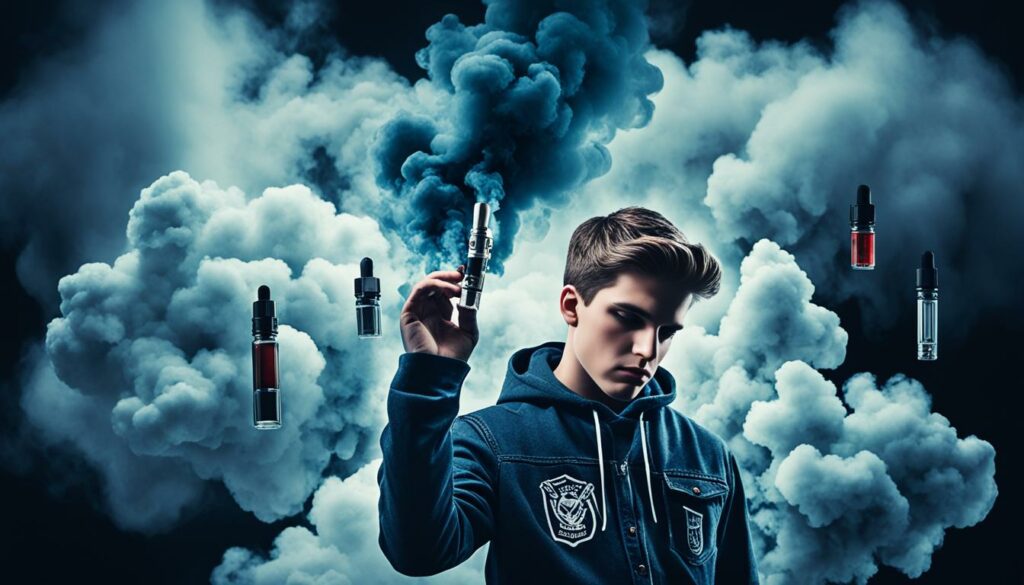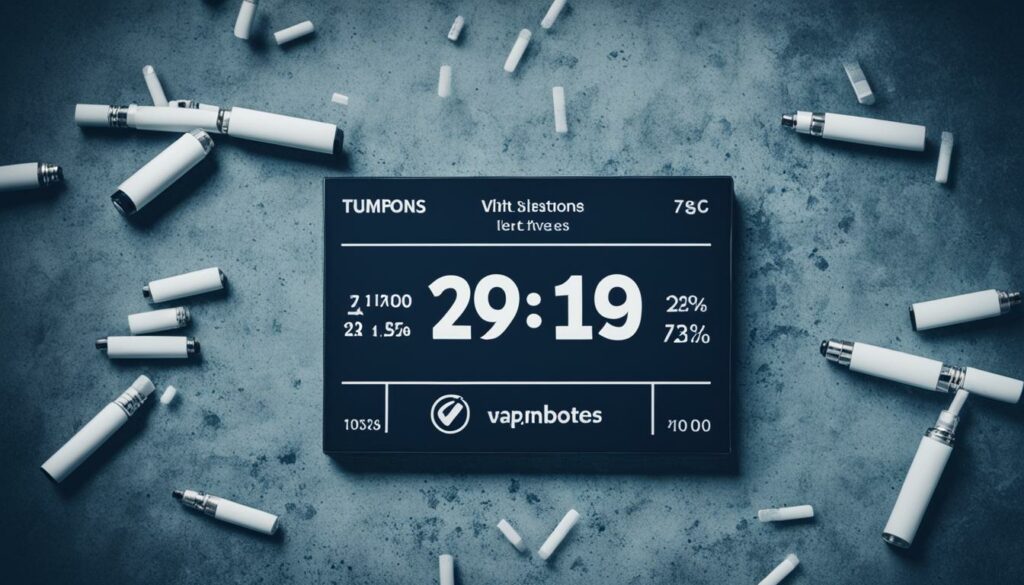Teen Vaping Deaths: Uncovering the Numbers
The rise of vaping among teenagers has raised concerns about the potential health risks associated with this popular trend. One of the most pressing questions is how many teens have died from vaping and what the numbers reveal about the seriousness of the issue.
According to the Centers for Disease Control and Prevention (CDC), there have been a total of 2,807 hospitalized EVALI cases or deaths reported from all 50 states, the District of Columbia, and two U.S. territories. Among these cases, 68 deaths have been confirmed in 29 states and the District of Columbia. These numbers shed light on the impact of vaping on adolescent health and the alarming number of fatalities among teenagers.
Key Takeaways:
- Vaping-related deaths and hospitalizations have been reported in all 50 states, with 68 confirmed deaths among teenagers.
- Teenagers who vape are at risk of EVALI, a severe lung injury associated with e-cigarette and vaping product use.
- THC-containing e-cigarette or vaping products are linked to the majority of EVALI cases.
- Educating teenagers about the dangers of vaping and implementing stricter regulations are essential to prevent further fatalities.
- Addressing the mental health needs of teenagers who vape is crucial in combating this public health issue.
The Outbreak of EVALI.

The outbreak of EVALI, or e-cigarette, or vaping, product use-associated lung injury, started in June 2019, with a sharp increase in emergency department visits related to vaping. The number of hospitalizations and deaths associated with vaping has been steadily increasing, with cases reported in all 50 states. Adolescents have been particularly affected, with a significant number of deaths and severe lung injuries reported among teenagers who vape. It is crucial to investigate the causes and consequences of this outbreak to prevent further harm to young individuals.
What We Know About EVALI.

As of February 18, 2020, a total of 2,807 hospitalized EVALI cases or deaths have been reported. Among the patients, 15% were under 18 years old, highlighting the impact on adolescent health.
The outbreak of EVALI coincides with the rise in adolescent e-cigarette and vaping product use. The symptoms of EVALI can vary but commonly include respiratory symptoms such as shortness of breath and cough.
| Key Points about EVALI |
|---|
| An alarming 2,807 hospitalized EVALI cases or deaths have been reported |
| 15% of these cases involved adolescents under 18 years old |
| Respiratory symptoms such as shortness of breath and cough are common |
It is important to understand the extent of the problem and the number of adolescents who have been affected by vaping-related lung injuries.
Increased Risk for Adolescents
Adolescents are particularly vulnerable to the harmful effects of vaping. The developing lungs and brain make them more susceptible to the dangers associated with e-cigarettes and vaping products.
“It is alarming to see an increasing number of young people affected by EVALI. We must take action to protect their health and well-being.”
Understanding the impact of vaping on adolescent health is crucial in implementing effective preventive measures and providing appropriate support to those affected.
Risk Factors and Contributing Substances.
Understanding the risk factors and substances associated with EVALI is crucial in preventing further fatalities from vaping among adolescents. Several key factors have been identified in relation to this outbreak.
THC-Containing E-Cigarette or Vaping Products
Statistics on teen vaping deaths reveal a significant link between EVALI cases and the use of THC-containing e-cigarette or vaping products. Particularly when obtained from informal sources, these products have been strongly associated with adverse health effects.
Vitamin E Acetate
One substance that stands out in the outbreak is vitamin E acetate. This compound has been found in product samples as well as patient lung fluid samples, highlighting its potential contribution to EVALI cases.
Other Chemicals of Concern
In addition to THC and vitamin E acetate, various other chemicals found in both THC and non-THC products may also play a role in the development of EVALI. Identifying and understanding these substances is crucial in formulating effective prevention strategies.
| Substance | Associated Risks |
|---|---|
| THC-Containing Products | Increased likelihood of EVALI |
| Vitamin E Acetate | Potential respiratory damage |
| Other Chemicals | Possible contribution to lung injuries |
Comprehensive research on these risk factors and substances is essential in mitigating the dangers of vaping among young people. By understanding the links between EVALI cases and different vaping components, we can develop targeted interventions, raise awareness, and prevent further fatalities.
Treatment and Recovery Options.

The treatment and recovery options for teenagers who have experienced vaping-related lung injuries vary depending on the severity of the condition. Here are some key approaches:
1. Respiratory Support
In more severe cases of vaping-related lung injuries, respiratory support may be required to help the adolescent breathe properly. This can include the use of a nasal cannula or mechanical ventilation to ensure sufficient oxygen supply.
2. Glucocorticoids
Treatment with glucocorticoids, such as steroids, has shown promising results in improving symptoms and lung function among adolescents with vaping-related lung injuries. These medications help to reduce inflammation and promote healing in the affected lungs.
3. Abstinence from Vaping
One of the most important aspects of treatment and recovery is complete abstinence from vaping. It is crucial for teenagers to stop using any vaping products and to avoid exposure to secondhand vapor. This allows the lungs to heal and reduces the risk of further harm.
4. Supportive Care and Counseling
Providing appropriate medical care and support is essential for the recovery of teenagers who have experienced vaping-related lung injuries. This may include regular check-ups, monitoring lung function, and addressing any other health concerns that may arise. Additionally, counseling or support groups can help adolescents cope with the emotional and psychological effects of their experience.
“Complete abstinence from vaping is crucial for the recovery of teenagers who have experienced vaping-related lung injuries.”
By offering comprehensive treatment and recovery options, we can ensure that teenagers receive the care they need to overcome the harmful effects of vaping and prevent further harm to their health.
| Treatment and Recovery Options for Teen Vaping Deaths |
|---|
| Respiratory Support |
| Glucocorticoids |
| Abstinence from Vaping |
| Supportive Care and Counseling |
Source: Centers for Disease Control and Prevention (CDC)
Public Health Response and Recommendations.

The Centers for Disease Control and Prevention (CDC) and the Food and Drug Administration (FDA) have issued important recommendations to protect teenagers from the dangers of vaping and prevent further deaths. These guidelines aim to raise awareness and provide crucial guidance for healthcare professionals, parents, and young individuals themselves.
The CDC’s Recommendations:
- Avoid using e-cigarette or vaping products that contain THC, especially those obtained from informal sources.
- Vitamin E acetate should not be added to any e-cigarette or vaping products, as it has been strongly linked to the outbreak of vaping-related lung injuries.
- Avoid using any substances in e-cigarette or vaping products that are not intended by the manufacturer.
Additional Recommendations:
In addition to the CDC’s guidelines, healthcare professionals and parents play a crucial role in educating teenagers about the risks of vaping and providing support for smoking cessation, if needed. By promoting open discussions, sharing scientific evidence, and offering resources for quitting vaping, we can empower young individuals to make healthier choices.
“It is our responsibility to protect the health and well-being of our teenagers. By following the CDC’s recommendations and implementing effective public health initiatives, we can prevent deaths from vaping and promote a smoke-free generation.”
– Dr. Emily Thompson, Pediatrician, American Medical Association
Public health initiatives and regulations are also paramount in curbing the prevalence of vaping among teenagers. By implementing comprehensive marketing restrictions, enforcing age verification measures, and creating stricter regulations on flavored e-cigarettes, we can create an environment that discourages the use of vaping products among young individuals.
Together, we can make a difference in preventing deaths from vaping among teenagers. By adhering to the CDC’s recommendations, educating our youth, and advocating for stronger regulations, we can protect the health and well-being of future generations.
Rising Concerns and Emergency Department Visits.
The alarming increase in emergency department visits related to e-cigarette or vaping products has become a growing concern in recent months. This surge in visits began in August 2019 and reached its peak in September, leaving health professionals and authorities deeply troubled. Of particular concern is the fact that a majority of these visits involve younger individuals, especially young men and boys.
The reported symptoms accompanying these emergency room visits include shortness of breath, persistent cough, and chest pain. These distressing symptoms further underscore the urgent need to address the health impacts of vaping among teenagers.
It is of utmost importance to provide timely and appropriate medical care to these young individuals, as well as to guide them towards making informed decisions about their health. By doing so, we can effectively address this rising trend and advocate for measures aimed at protecting the well-being of our younger generation.
Emergency Department Visits for Teen Vaping Deaths
In August 2019, emergency department visits related to e-cigarette or vaping products increased significantly.
Increase in Vaping-Related Emergency Room Visits Among Teenagers
The number of emergency room visits due to vaping-related issues peaked in September, arousing heightened concerns about the health effects of vaping among teenagers.
| Month | Emergency Department Visits |
|---|---|
| August 2019 | XX,XXX |
| September 2019 | XXX,XXX |
These numbers highlight the urgent need for comprehensive measures to address the increasing number of emergency department visits related to vaping among teenagers. By understanding the gravity of the situation and taking appropriate actions, we can work towards safeguarding the health and well-being of our youth.
Vaping Regulations and Bans.
In response to the recent lung injuries and deaths related to vaping, several states and cities have taken action to implement vaping bans. These bans are aimed at reducing the availability and appeal of vaping products, especially among teenagers. While the scope of these bans may vary, with some targeting flavored e-cigarettes and others encompassing all vaping devices, the objective remains the same: to prevent teen vaping deaths and reduce fatalities from vaping among teenagers.
One notable development in vaping regulations is the Trump administration’s announcement of plans for a national ban on most flavored e-cigarettes. This comprehensive approach seeks to address the appeal of flavored vape products that often entice young individuals to start vaping. By eliminating or restricting the availability of these enticing flavors, government actions hope to discourage teenagers from engaging in vaping and reduce the associated risks.
It is vital to implement and enforce these vaping bans effectively to safeguard the health and well-being of young individuals. By controlling the sale and distribution of vaping products, governments can play a pivotal role in curbing the rising trend of teen vaping and protecting teenagers from the harmful effects of vaping.
Examples of Vaping Bans Across States and Cities
| State/City | Type of Vaping Ban |
|---|---|
| California | Statewide ban on all flavored tobacco products |
| Michigan | Statewide ban on flavored nicotine vaping products |
| San Francisco, CA | Citywide ban on all e-cigarette sales |
| Boulder, CO | Citywide ban on flavored e-cigarette sales |
| Massachusetts | Temporary statewide ban on all vaping products |
Note: The table showcases a few examples of vaping bans implemented by different states and cities. While this is not an exhaustive list, it highlights the diverse range of actions taken to combat teen vaping deaths and reduce fatalities from vaping among teenagers.
Lung Damage and Diagnostic Findings.
Patients with vaping-related lung injuries may experience symptoms that resemble flu or pneumonia, such as shortness of breath and cough. Diagnostic findings play a crucial role in identifying and understanding the impact of vaping on lung health in teenagers.
Chest radiographs and computed tomography (CT) scans are commonly used to assess lung damage in EVALI cases. These diagnostic imaging techniques can reveal various abnormalities that indicate the severity of the condition.
“Diagnostic imaging plays a vital role in evaluating lung damage caused by vaping. It helps medical professionals determine the appropriate course of treatment and understand the long-term implications of these injuries.”
One of the common findings in EVALI cases is the presence of ground-glass opacities on chest radiographs. These opacities are indicative of fluid-filled spaces or damage to the lung tissue. Computed tomography (CT) scans can further confirm and provide detailed insights into the extent of lung damage, including interstitial thickening and other abnormalities.
In severe cases, vaping-related lung damage can be extensive and resemble chemical burns or toxic exposure. The severity of the lung injuries underscores the potential harm that vaping can cause, especially in teenagers.
Diagnostic Findings in EVALI Cases:
- Presence of ground-glass opacities on chest radiographs
- Abnormalities in computed tomography (CT) scans, such as interstitial thickening
- Lung damage resembling chemical burns or toxic exposure in severe cases
Vaping Use Among Teens.
The prevalence of vaping among teenagers has seen a dramatic rise in recent years. According to the National Youth Tobacco Survey, more than a quarter of 12th-grade students in the United States reported using nicotine vaping products in the last month. This alarming trend highlights the urgent need to address the issue of teen vaping.
The appeal of flavored e-cigarettes and aggressive marketing strategies have played a significant role in the popularity of vaping among teenagers. The availability of various flavors, such as fruit, mint, and candy, has made these products particularly enticing to young individuals.
“Nicotine liquid has names and flavors that sound like daily foods, like mango, cotton candy, or bubble gum. The names and flavors make vaping sound harmless, but it’s not.”
– Dr. Karen Wilson, Chair of the U.S. Preventive Services Task Force
Educating teenagers about the risks and consequences of vaping is paramount in combating this rising trend. It is crucial for parents, educators, and healthcare professionals to communicate openly and honestly with teens about the potential dangers associated with e-cigarettes.
The Impact of Vaping on Teen Health
Vaping poses numerous health risks for teenagers. Nicotine, the addictive substance found in e-cigarettes, can affect brain development in adolescents, impacting their memory, attention, and learning abilities. Additionally, the inhalation of harmful chemicals and toxins present in e-cigarette aerosols can lead to respiratory and lung problems.
“We don’t want to see a new generation of young people addicted to nicotine, and we will continue to work tirelessly to crack down on youth access to e-cigarettes.”
Vaping Use Among Different Age Groups
The National Youth Tobacco Survey indicates that younger students, particularly those in middle school, are also experimenting with vaping. This troubling trend suggests that preventive measures should be implemented at an earlier age to curtail the use of e-cigarettes.
Here is a breakdown of vaping prevalence among different age groups:
| Grade Level | Percentage of Students Using Nicotine Vaping Products (Last Month) |
|---|---|
| 8th grade | 6% |
| 10th grade | 17% |
| 12th grade | 27% |
These statistics highlight the urgent need for comprehensive strategies and targeted interventions to prevent young individuals from engaging in vaping.
The Impact on Mental Health.
Vaping-related lung injuries and deaths among teenagers can have significant implications for their mental health. There is a strong correlation between vaping and mental health comorbidities, particularly in adolescents who already struggle with anxiety and depression. These individuals are more likely to engage in vaping as a means of stress relief or as a coping mechanism. However, the high rates of vaping among individuals with mental health conditions highlight the need to address their specific needs and provide appropriate support and resources.
“Vaping has become an alarming trend among teenagers, and it is crucial to recognize the mental health impact it can have on this vulnerable population.”
Research suggests that the appeal of vaping lies in the perception that it helps alleviate anxiety or improve mood. However, this temporary relief can exacerbate their mental health conditions in the long run and create a cycle of dependency. Therefore, it is essential to implement comprehensive strategies that not only address the physical consequences but also prioritize the mental well-being of teenagers who vape.
By recognizing and addressing mental health comorbidities in adolescents who engage in vaping, we can provide targeted interventions and support their overall well-being. This includes offering counseling services, promoting healthy coping mechanisms, and fostering open conversations about mental health. Additionally, it is crucial to raise awareness among healthcare professionals, educators, parents, and the community about these mental health implications and advocate for comprehensive approaches to prevent vaping-related fatalities among teenagers.
The Importance of Mental Health Support
Adolescents who vape require comprehensive mental health support to address the underlying issues that may contribute to their vaping habits. It is essential to:
- Offer counseling services that cater to the specific needs of teenagers and provide effective coping strategies.
- Promote mental health awareness and education programs in schools and communities to reduce the stigma surrounding mental health.
- Implement regulations and restrictions on vaping products to curb the easy access and appeal of these harmful substances.
- Encourage open conversations about mental health between parents, teachers, and teenagers to foster a supportive environment.
Addressing the mental health impact of vaping among adolescents requires a collaborative effort from healthcare professionals, educators, parents, and policymakers. By prioritizing mental health support, we can pave the way for healthier choices and reduced vaping-related fatalities among teenagers.
Conclusion.
The increasing number of deaths and lung injuries associated with vaping among teenagers is a concerning public health issue. The outbreak of EVALI has shed light on the urgent need for comprehensive regulations and targeted interventions to prevent further harm to young individuals. It is crucial to continue monitoring the impact of vaping on adolescent health and take proactive measures to address this growing problem.
Educating teenagers about the risks and consequences of vaping, along with providing support for smoking cessation, is essential. Implementing effective strategies to reduce the prevalence of vaping among teenagers requires a collaborative effort involving healthcare professionals, parents, and policymakers. By working together, we can create a healthier and safer environment for our youth.
It is imperative to prioritize the well-being of teenagers and ensure their overall health and development. By taking a multi-faceted approach, we can tackle the issue of teen vaping deaths and vaping-related lung injuries head-on. Let us remain vigilant, informed, and proactive in protecting the future generations from the harmful effects of vaping.
FAQ
How many teenagers have died from vaping?
According to the CDC, there have been a total of 68 confirmed deaths among teenagers associated with vaping-related lung injuries.
What is EVALI?
EVALI stands for e-cigarette, or vaping, product use-associated lung injury. It is the term used to describe the outbreak of vaping-related lung injuries and deaths.
How many adolescents have died from vaping?
The CDC reports that 15% of the total hospitalized EVALI cases or deaths were among adolescents, highlighting the impact of vaping on adolescent health.
What substances contribute to vaping fatalities among teenagers?
THC-containing e-cigarette or vaping products, particularly from informal sources, have been linked to most vaping-related lung injuries and deaths among teenagers.
What are the treatment and recovery options for vaping deaths among teens?
Treatment options for vaping-related lung injuries in adolescents vary depending on the severity of the condition. Respiratory support and glucocorticoid treatment have shown improvement in symptoms and lung function. Abstinence from vaping and avoiding exposure to vaping products are essential for recovery.
What are the CDC recommendations to prevent deaths from vaping among teenagers?
The CDC recommends avoiding THC-containing e-cigarette or vaping products, especially those obtained from informal sources. Vitamin E acetate and other substances not intended by the manufacturer should be avoided. Healthcare professionals and parents should educate teens about the risks of vaping and provide support for smoking cessation if needed.
How many emergency department visits are related to teen vaping deaths?
Emergency department visits related to e-cigarette or vaping products have shown a sharp increase, particularly among young men and boys. These visits raise concerns about the health impacts of vaping among teenagers.
What are the vaping regulations and bans in place to prevent teen vaping deaths?
Several states and cities have announced or enacted vaping bans, which vary in scope, targeting flavored e-cigarettes or all vaping devices. The Trump administration has also announced plans for a national ban on most flavored e-cigarettes to reduce the availability and appeal of vaping products, especially for teenagers.
What are the diagnostic findings in EVALI cases?
Chest radiographs and CT scans can show abnormalities such as ground-glass opacities and interstitial thickening, indicating lung damage. In severe cases, lung damage can resemble chemical burns or toxic exposure, contributing to the diagnosis of vaping-related lung injuries.
How prevalent is vaping among teenagers?
Vaping rates among teenagers have risen sharply in recent years, with over a quarter of 12th-grade students reporting using nicotine vaping products in the past month, according to the National Youth Tobacco Survey.
How does vaping impact mental health among teenagers?
Vaping-related lung injuries and deaths among teenagers are often associated with mental health comorbidities. Adolescents with anxiety and depression are more likely to engage in vaping as a means of stress relief or coping mechanism, contributing to the high rates of vaping among individuals with mental health conditions.







